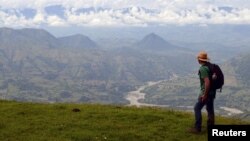The continents of North and South America came together much earlier than previously thought, according to researchers who found evidence in rock deposits from ancient rivers in Colombia of the land bridge that connected the long-isolated land masses.
The two continents are linked at Panama, but there has been a debate about when this land bridge first appeared, with most experts placing its formation at about 3 million years ago.
The new study, published Thursday in the journal Science, presents evidence that the Panama land bridge formed at least 10 million years earlier. Until then, a deep water channel called the Central American Seaway separated the continents.
The researchers base their estimate on the presence of small grains of a mineral called zircon unearthed in ancient river bedrock in northern Colombia that originated in Panama and were 13 million to 15 million years old. These grains suggested the land bridge must have existed at that time, they said.
"We contend that a bridge, perhaps a transient one, was present since 13 million to 15 million years ago,'' said geologist Camilo Montes of Universidad de los Andes in Bogota, who led the study.
The various continents, sitting atop huge plates akin to jigsaw puzzle pieces sliding over Earth's mantle, have slowly moved around the globe during the planet's history. They have separated, drifted and joined numerous times in a process called plate tectonics.
South America became an isolated land mass when it separated from Africa. Likewise, North America broke apart from Europe and headed on a gradual collision course with South America.
One of the most dramatic results of the joining of the two Americas was the mixing of the animals living on the respective land masses, with various creatures crossing the land bridge to invade the other continent. The event is known as the Great American Biological Interchange.
South America had a unique animal population, with exotic marsupials including saber-toothed predators, as well as elephant-sized ground sloths; car-sized armadillos; camel-like creatures with elephant trunks; and giant, flightless, carnivorous "terror birds.''
North America had a quite different and impressive array of placental mammals, including saber-toothed cats and other feline predators; huge, short-faced bears; wolves; and various herbivores, including big elephant relatives and horses.
The two continents continue to move together.
"Yes, the plates are moving today,'' Montes said. ``They never stop.''













